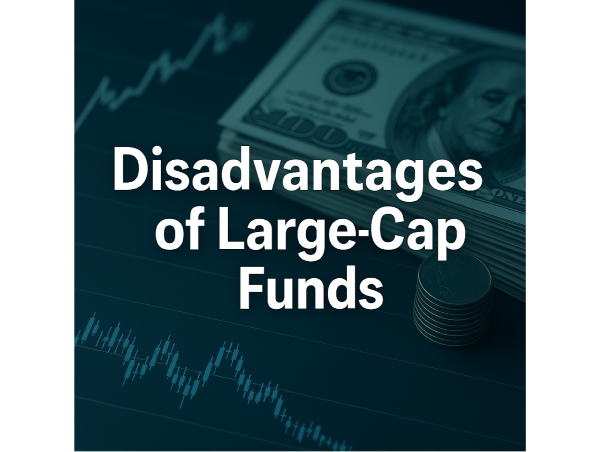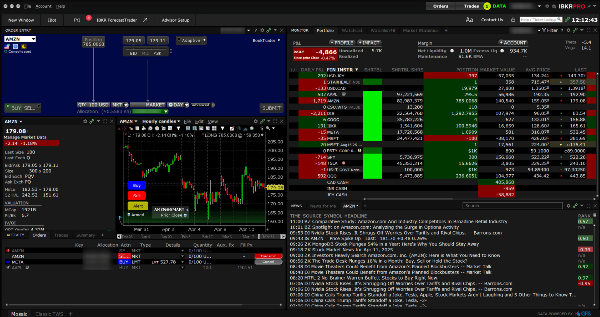Introduction
Large-cap funds invest in companies with high market capitalizations, typically exceeding $10 billion. These funds are popular among investors due to their stability, strong financial backing, and ability to provide consistent returns. Large-cap funds are often favored for their lower volatility and reliable dividend payouts, making them attractive for conservative investment strategies. However, despite their advantages, these funds come with certain drawbacks that investors should consider. This article explores the disadvantages of large-cap funds, highlighting factors such as limited growth potential, valuation concerns, and market sensitivity to help investors make informed decisions.
Limited Growth Potential
Large-cap companies are well-established industry leaders, often operating at peak efficiency within saturated markets. Their size and stability make them attractive to investors seeking consistent returns, but they also limit opportunities for aggressive expansion. Unlike small-cap and mid-cap companies, which have room for innovation and market penetration, large-cap firms typically grow at a slower pace. This reduced growth potential can make them less appealing to investors looking for high capital appreciation.
Compared to small and mid-cap funds, large-cap funds generally exhibit lower growth rates. Small-cap stocks, often in emerging industries, have the potential for rapid expansion and higher returns. Mid-cap stocks offer a balance between growth and stability, making them attractive to investors who want moderate risk with reasonable upside potential. Large-cap stocks, while stable, tend to focus on maintaining market share rather than expanding aggressively, which can limit their ability to outperform smaller companies in bullish market conditions.
Historical performance data highlights the differences in growth potential across market cap segments. Studies show that small-cap stocks have historically outperformed large-cap stocks over extended periods, particularly during economic recoveries. Mid-cap stocks also tend to deliver higher returns than large-cap stocks, benefiting from both stability and growth opportunities. While large-cap stocks provide security and lower volatility, their constrained expansion potential means they may not generate the same level of returns as smaller companies in favorable market conditions.
High Valuation Concerns
Large-cap stocks frequently trade at premium valuations due to their strong financial performance and market dominance. Investors often pay higher prices for these stocks, assuming their stability and consistent earnings will justify the cost. However, elevated price-to-earnings (P/E) ratios can limit future returns, as stocks priced too high may struggle to generate significant upside. Historically, large-cap stocks with excessive valuations have underperformed during market corrections, as investors shift toward undervalued opportunities.
Overpaying for large-cap stocks can pose risks, particularly when market conditions change. If earnings growth slows or economic downturns occur, highly valued stocks may experience sharp declines. Additionally, concentration in a few high-priced stocks can create market imbalances, making portfolios vulnerable to sector-specific downturns. Investors should carefully assess valuation metrics and consider diversification strategies to mitigate risks associated with overpriced large-cap stocks.
Lower Returns Compared to Small and Mid-Cap Funds
Large-cap funds tend to deliver lower returns compared to small and mid-cap funds over extended periods. Historical data shows that small-cap and mid-cap stocks often outperform large-cap stocks due to their higher growth potential and ability to capitalize on emerging market opportunities. While large-cap stocks provide stability, their mature business models limit rapid expansion, making them less likely to generate outsized returns. Studies indicate that mid-cap stocks, in particular, have historically delivered the highest annualized returns, balancing growth with moderate risk.
Market trends further highlight instances where large-cap funds have underperformed. During economic recoveries, small-cap stocks tend to rebound faster, benefiting from increased investor confidence and expansion opportunities. Mid-cap stocks also show strong performance during bullish market cycles, whereas large-cap stocks often lag due to their conservative growth strategies.
Additionally, sector-specific downturns can disproportionately affect large-cap stocks, particularly in industries with slower innovation cycles. Investors seeking higher returns may consider diversifying into mid-cap and small-cap funds to optimize portfolio growth.
Sensitivity to Market Downturns
Large-cap stocks, despite their stability, are not immune to market downturns. During recessions, these stocks can experience sharp declines as investors shift toward safer assets like bonds or cash. While large-cap companies often have strong financial foundations, economic contractions can lead to reduced consumer spending, lower corporate earnings, and declining stock prices. Historical data shows that large-cap stocks have suffered significant losses during major financial crises, such as the 2008 recession, when the S&P 500 dropped by over 50%.
Case studies of past economic downturns highlight the vulnerabilities of large-cap funds. For example, during the dot-com bubble burst in the early 2000s, many large-cap technology stocks saw dramatic declines, wiping out billions in market value. Similarly, the COVID-19 pandemic in 2020 led to sharp sell-offs in large-cap stocks, particularly in industries like travel, retail, and energy. While some companies rebounded quickly, others struggled to recover, demonstrating that even industry leaders are susceptible to economic shocks.
Diversification is crucial for mitigating risks associated with large-cap stocks during downturns. Investors can balance their portfolios by including assets such as mid-cap and small-cap stocks, bonds, and alternative investments. A well-diversified portfolio can help reduce exposure to large-cap stock volatility while maintaining long-term growth potential. Additionally, actively managed funds may provide better risk management during market disruptions compared to passive index funds, as they can adjust holdings based on economic conditions.
Conclusion
Large-cap funds offer stability, steady returns, and institutional backing, making them appealing for conservative investors, yet they come with drawbacks that limit their growth potential and responsiveness to market shifts. High valuations can restrict future returns, and their reliance on dividends can make them less competitive in bullish cycles where smaller stocks outperform.
Additionally, sector concentration and sensitivity to economic downturns can lead to underperformance, emphasizing the need for diversification. While they remain valuable for risk-averse investors, understanding their limitations and balancing them with mid- and small-cap funds can enhance long-term portfolio performance and overall financial resilience.






























Introduction
Large-cap funds invest in companies with high market capitalizations, typically exceeding $10 billion. These funds are popular among investors due to their stability, strong financial backing, and ability to provide consistent returns. Large-cap funds are often favored for their lower volatility and reliable dividend payouts, making them attractive for conservative investment strategies. However, despite their advantages, these funds come with certain drawbacks that investors should consider. This article explores the disadvantages of large-cap funds, highlighting factors such as limited growth potential, valuation concerns, and market sensitivity to help investors make informed decisions.
Limited Growth Potential
Large-cap companies are well-established industry leaders, often operating at peak efficiency within saturated markets. Their size and stability make them attractive to investors seeking consistent returns, but they also limit opportunities for aggressive expansion. Unlike small-cap and mid-cap companies, which have room for innovation and market penetration, large-cap firms typically grow at a slower pace. This reduced growth potential can make them less appealing to investors looking for high capital appreciation.
Compared to small and mid-cap funds, large-cap funds generally exhibit lower growth rates. Small-cap stocks, often in emerging industries, have the potential for rapid expansion and higher returns. Mid-cap stocks offer a balance between growth and stability, making them attractive to investors who want moderate risk with reasonable upside potential. Large-cap stocks, while stable, tend to focus on maintaining market share rather than expanding aggressively, which can limit their ability to outperform smaller companies in bullish market conditions.
Historical performance data highlights the differences in growth potential across market cap segments. Studies show that small-cap stocks have historically outperformed large-cap stocks over extended periods, particularly during economic recoveries. Mid-cap stocks also tend to deliver higher returns than large-cap stocks, benefiting from both stability and growth opportunities. While large-cap stocks provide security and lower volatility, their constrained expansion potential means they may not generate the same level of returns as smaller companies in favorable market conditions.
High Valuation Concerns
Large-cap stocks frequently trade at premium valuations due to their strong financial performance and market dominance. Investors often pay higher prices for these stocks, assuming their stability and consistent earnings will justify the cost. However, elevated price-to-earnings (P/E) ratios can limit future returns, as stocks priced too high may struggle to generate significant upside. Historically, large-cap stocks with excessive valuations have underperformed during market corrections, as investors shift toward undervalued opportunities.
Overpaying for large-cap stocks can pose risks, particularly when market conditions change. If earnings growth slows or economic downturns occur, highly valued stocks may experience sharp declines. Additionally, concentration in a few high-priced stocks can create market imbalances, making portfolios vulnerable to sector-specific downturns. Investors should carefully assess valuation metrics and consider diversification strategies to mitigate risks associated with overpriced large-cap stocks.
Lower Returns Compared to Small and Mid-Cap Funds
Large-cap funds tend to deliver lower returns compared to small and mid-cap funds over extended periods. Historical data shows that small-cap and mid-cap stocks often outperform large-cap stocks due to their higher growth potential and ability to capitalize on emerging market opportunities. While large-cap stocks provide stability, their mature business models limit rapid expansion, making them less likely to generate outsized returns. Studies indicate that mid-cap stocks, in particular, have historically delivered the highest annualized returns, balancing growth with moderate risk.
Market trends further highlight instances where large-cap funds have underperformed. During economic recoveries, small-cap stocks tend to rebound faster, benefiting from increased investor confidence and expansion opportunities. Mid-cap stocks also show strong performance during bullish market cycles, whereas large-cap stocks often lag due to their conservative growth strategies.
Additionally, sector-specific downturns can disproportionately affect large-cap stocks, particularly in industries with slower innovation cycles. Investors seeking higher returns may consider diversifying into mid-cap and small-cap funds to optimize portfolio growth.
Sensitivity to Market Downturns
Large-cap stocks, despite their stability, are not immune to market downturns. During recessions, these stocks can experience sharp declines as investors shift toward safer assets like bonds or cash. While large-cap companies often have strong financial foundations, economic contractions can lead to reduced consumer spending, lower corporate earnings, and declining stock prices. Historical data shows that large-cap stocks have suffered significant losses during major financial crises, such as the 2008 recession, when the S&P 500 dropped by over 50%.
Case studies of past economic downturns highlight the vulnerabilities of large-cap funds. For example, during the dot-com bubble burst in the early 2000s, many large-cap technology stocks saw dramatic declines, wiping out billions in market value. Similarly, the COVID-19 pandemic in 2020 led to sharp sell-offs in large-cap stocks, particularly in industries like travel, retail, and energy. While some companies rebounded quickly, others struggled to recover, demonstrating that even industry leaders are susceptible to economic shocks.
Diversification is crucial for mitigating risks associated with large-cap stocks during downturns. Investors can balance their portfolios by including assets such as mid-cap and small-cap stocks, bonds, and alternative investments. A well-diversified portfolio can help reduce exposure to large-cap stock volatility while maintaining long-term growth potential. Additionally, actively managed funds may provide better risk management during market disruptions compared to passive index funds, as they can adjust holdings based on economic conditions.
Conclusion
Large-cap funds offer stability, steady returns, and institutional backing, making them appealing for conservative investors, yet they come with drawbacks that limit their growth potential and responsiveness to market shifts. High valuations can restrict future returns, and their reliance on dividends can make them less competitive in bullish cycles where smaller stocks outperform.
Additionally, sector concentration and sensitivity to economic downturns can lead to underperformance, emphasizing the need for diversification. While they remain valuable for risk-averse investors, understanding their limitations and balancing them with mid- and small-cap funds can enhance long-term portfolio performance and overall financial resilience.